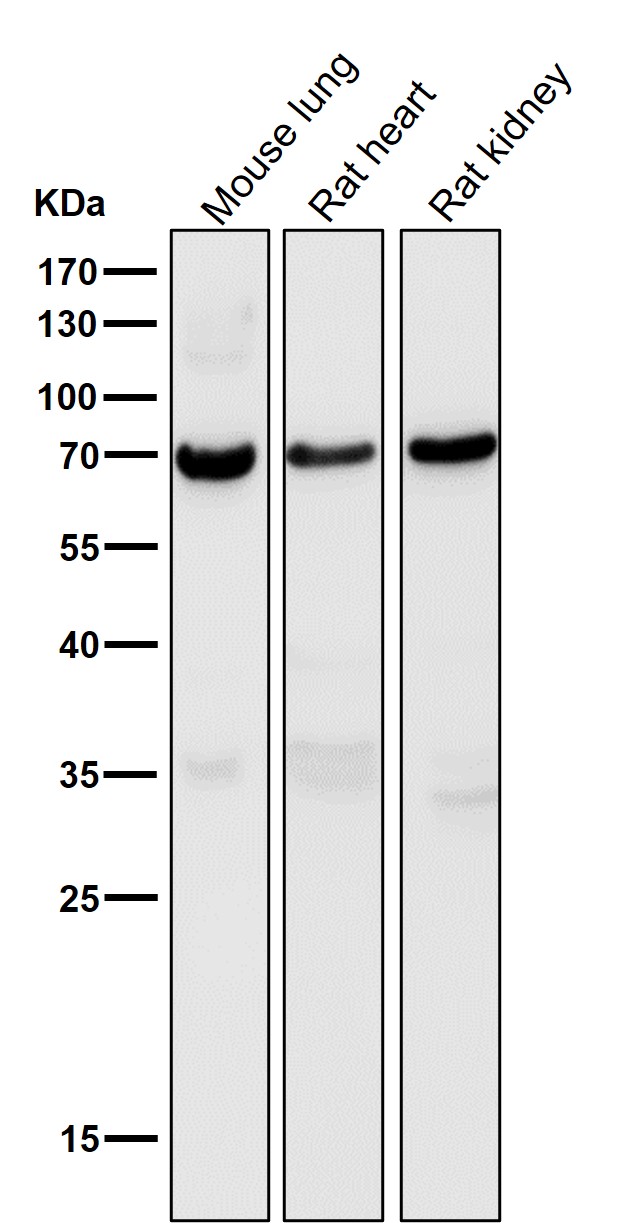

| WB | 咨询技术 | Human,Mouse,Rat |
| IF | 咨询技术 | Human,Mouse,Rat |
| IHC | 咨询技术 | Human,Mouse,Rat |
| ICC | 1/50-1/200 | Human,Mouse,Rat |
| FCM | 咨询技术 | Human,Mouse,Rat |
| Elisa | 咨询技术 | Human,Mouse,Rat |
| Aliases | Lipid droplet associated protein; PERI; Perilipin-1; PerilipinA; LIN1;;Perilipin 1 |
| WB Predicted band size | Calculated MW: 56 kDa ; Observed MW: 62 kDa |
| Host/Isotype | Rabbit IgG |
| Antibody Type | Primary antibody |
| Storage | Store at 4°C short term. Aliquot and store at -20°C long term. Avoid freeze/thaw cycles. |
| Species Reactivity | Human,Mouse |
| Immunogen | A synthesized peptide derived from human Perilipin 1 |
| Formulation | Purified antibody in PBS with 0.05% sodium azide,0.05% BSA and 50% glycerol. |
+ +
以下是关于PerilipinA抗体的3篇代表性文献,简要总结如下:
1. **文献名称**:*"Perilipin A is essential for the translocation of hormone-sensitive lipase during lipolytic activation"*
**作者**:Sztalryd, C., Xu, G., Dorward, H., & Tansey, J.T.
**摘要**:该研究利用PerilipinA特异性抗体,通过免疫荧光和Western blot分析,揭示了PerilipinA在脂肪细胞脂解过程中对激素敏感性脂肪酶(HSL)定位的关键作用,证明其磷酸化是脂解激活的必要步骤。
2. **文献名称**:*"Adipocyte differentiation-related protein and perilipin are coordinately regulated during activation of lipolysis in adipocytes"*
**作者**:Brasaemle, D.L., Rubin, B., Harten, I.A., et al.
**摘要**:通过PerilipinA抗体检测,研究发现PerilipinA与ADRP(Adipocyte Differentiation-Related Protein)在脂肪细胞脂解过程中的协同调控机制,揭示了二者在脂滴稳定性与分解中的动态平衡。
3. **文献名称**:*"Perilipin expression in human adipose tissues: effects of obesity, weight loss, and regulation by insulin"*
**作者**:Mottagui-Tabar, S., Rydén, M., Löfgren, P., et al.
**摘要**:该文献使用PerilipinA抗体分析人类脂肪组织样本,发现肥胖个体中PerilipinA蛋白表达显著降低,且体重减轻或胰岛素干预后可上调,提示其与代谢紊乱的潜在关联。
(注:以上内容为示例,实际文献可能存在差异,建议通过PubMed或Google Scholar核对最新研究。)
PerilipinA (PLIN1) is a lipid droplet-associated protein critical for regulating lipid storage and metabolism in adipocytes. As a member of the PAT family (Perilipin, ADRP, TIP47), it coats the surface of lipid droplets, acting as a protective barrier against uncontrolled lipolysis by inhibiting adipose triglyceride lipase (ATGL) and hormone-sensitive lipase (HSL). Its phosphorylation in response to adrenergic signaling triggers lipolytic enzyme recruitment, enabling controlled lipid breakdown.
Anti-PLINA antibodies are essential tools for studying adipose biology, metabolic disorders, and cellular lipid dynamics. They enable detection of PLINA expression via techniques like Western blotting, immunofluorescence, and immunohistochemistry. These antibodies help differentiate adipocyte maturation stages, as PLINA expression increases during lipid droplet formation and adipocyte differentiation. Research applications include obesity, diabetes, and non-alcoholic fatty liver disease (NAFLD) studies, where PLINA dysregulation is implicated.
Commercial PLINA antibodies are typically raised against specific epitopes (e.g., human PLINA N-terminus) and validated for cross-reactivity in common models (mice, rats). Validation ensures specificity, as PLINA shares structural homology with other PAT proteins. Reliable antibodies aid in exploring lipid storage mechanisms, therapeutic targets, and metabolic adaptations, making them indispensable in obesity-related research and diagnostic development.
×